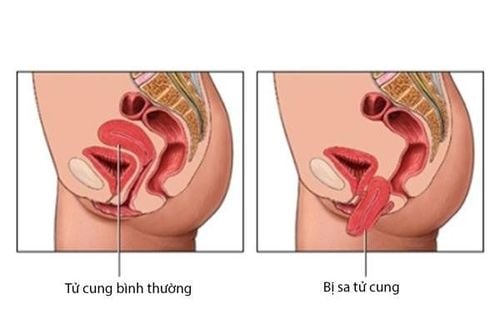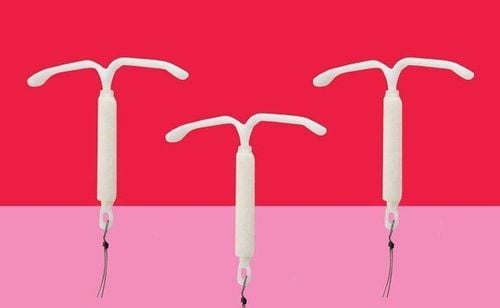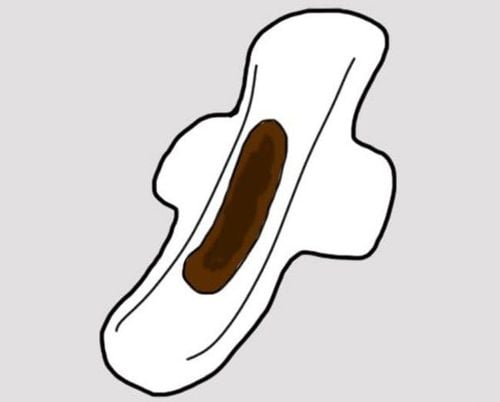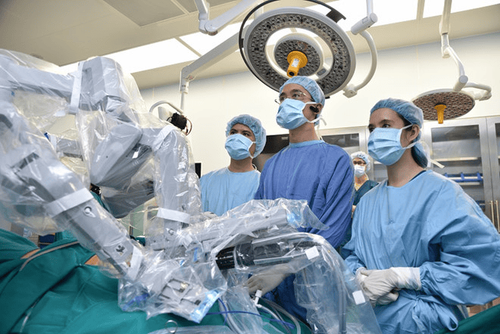This is an automatically translated article.
The article was professionally consulted by Specialist Doctor II Bui Thi Thu and Specialist Doctor II Tran Thi Mai Huong - Department of Obstetrics and Gynecology - Vinmec Hai Phong International General Hospital.Genital prolapse (uterine prolapse) is a condition that occurs when the pelvic floor muscles and ligaments stretch and weaken, making it impossible to lift the uterus effectively. It often occurs in pregnant and perimenopausal women due to changes during childbirth and hormonal changes during menopause.
1. Why is genital prolapse common in postpartum and premenopausal women?
When women enter menopause, the amount of female hormone oestrogen decreases significantly, making the ligaments in the abdomen lose their elasticity and reduce their strength very quickly, causing excessive stretching and unable to support the uterus.
Pregnancy and childbirth are also predisposing factors to genital prolapse. During pregnancy, the tissues in the abdomen stretch with the growth of the fetus. Especially when pushing the baby out at birth, the bottom of the abdomen must contract and stretch, which can easily injure and tear the pelvic ligaments.
As a result, the pelvic connective tissue is needed to support the uterus. When the connective tissue structure is weakened, contractions can cause the vaginal support tissue to crack and cause organ prolapse.
2. Some risk factors increase the possibility of genital prolapse in postpartum and premenopausal women
2.1 For pregnant women Vaginal birth Giving birth with twins, multiples or too large fetuses Pregnant at an advanced age Having multiple pregnancies Having placental anomalies with comb teeth Increase intra-abdominal pressure (during delivery) Congenital uterine cavity abnormalities (dual uterus, also known as bicornuate uterus) Medical intervention during delivery (use of the fertility drug oxytocin) ). 2.2 For premenopausal women Decreased estrogen (during menopause and perimenopause) Increased intra-abdominal pressure (during childbirth and heavy labor) Congenital uterine cavity abnormalities (dual uterus) aka bicornuate uterus ) Postmenopausal collagen network disorder Uterine surgery.
3. Symptoms of genital prolapse

4. Living regimen for women with genital prolapse
Women can manage prolapse by:
Avoiding heavy work especially during pregnancy Not having too many pregnancies Greater access to emergency obstetric services Avoiding drug abuse (only take medication prescribed by your doctor). In addition, women with genital prolapse should:
Exercise regularly every day even during pregnancy to cope with uterine prolapse and prevent complications to the mother and baby's health. Maintain a reasonable weight, eat a lot of vegetables to avoid constipation Perform specialized exercises to strengthen the pelvic floor muscles Avoid damage to the abdominal muscles during childbirth, do not tear or break. Currently, there are many effective surgical treatment methods for genital prolapse. Depending on the extent of the examination, the doctor will prescribe medical or surgical intervention. At Vinmec International General Hospital, robotic laparoscopic surgery is the optimal method for any genital prolapse. With this method, the patient will have advantages such as non-recurrence of the disease, preservation of the uterus and resolution of accompanying urinary symptoms of the disease.
Da Vinci robot made in the USA is an advanced, sophisticated, modern robot with 4 arms that almost perfectly simulate human hand movements, meeting the needs of surgery with requirements. tallest. Thanks to this feature, surgical robots can penetrate narrow, deep and difficult to reach locations, solving the limitations of classical open and laparoscopic surgery. With outstanding advantages: Safety, minimizing the risk of complications and surgical infection, pain relief, less blood loss, quick recovery, ensuring aesthetics, the robot can be used for most surgeries. cases must be treated with endoscopic methods especially in cancer treatment.
Please dial HOTLINE for more information or register for an appointment HERE. Download MyVinmec app to make appointments faster and to manage your bookings easily.














